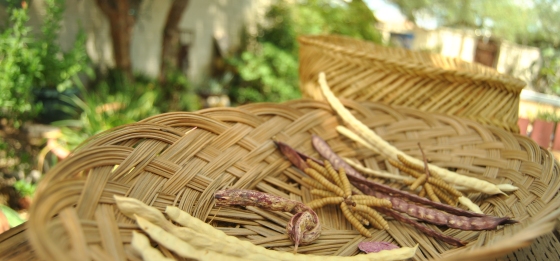July 19, 2013
Tucson, Arizona
When Laurie Melrood, a social worker who counsels undocumented immigrants, moved to Tucson a decade ago, her motto changed from ‘eat your garden’ to ‘eat your yard.’ It wasn’t an easy transition. For a while, she brooded about the soil conditions behind her house. Then, one afternoon, a Yaqui friend came over, climbed a tree, and started shaking down mesquite pods. Melrood hadn’t given the trees much thought before this moment—in fact, she’d swept the pods off her patio to throw them away. But the stubborn desert plant soon captivated her, and today, Melrood holds mesquite workshops at her home a dozen times a year. She teaches the history and uses of mesquite, then takes the group to harvest pods from trees at nearby Joaquin Murietta Park.
“I really like the ‘aha’ moment—when people are surprised,” Melrood said. Mesquite is considered a ‘ranging pest’ in some countries: the tree has a taproot that can grow 70 feet, overwhelming nearby vegetation. But it is this deep root that allows mesquite to survive in harsh desert conditions.

Laurie Melrood holds mesquite workshops at her home in Tucson, teaching the history and practical uses of the plant
We stayed with Melrood and her husband, Blake Gentry, in northwest Tucson (after Gentry extended us an invitation through our blog) and woke up on the morning of July 19th to coffee, mesquite mundlebread, and—imagine our luck—a mesquite workshop. Six women sat around the table, all there for different reasons: One liked to cook, one liked the rattle sound of the mesquite plant, one was working with members of the Tohono O’odham nation, 80 percent of whom are afflicted with diabetes. Melrood assured the workshop participants that, with hundreds of nutritional and medicinal uses, mesquite offers something for everybody.

The annual mesquite milling in the Dunbar Spring neighborhood brings people together to grind mesquite pods into flour. | Photo: Desert Harvesters
Her workshop is part of a larger movement in Tucson to harvest food from desert-adapted plants. Desert Harvesters, a non-profit group of mesquite enthusiasts, upped the ante a decade ago by purchasing a hammermill that quickly grinds mesquite pods. Every year since 2003, harvesters have hauled their bounty to an annual milling event in Dunbar Spring (a downtown neighborhood described in our earlier post) and then cooked up a pancake breakfast with the mesquite flour. It’s fun, and it builds community, but it’s also part of Desert Harvester’s mission to enhance local food security.

This map shows ‘food deserts’ in Tucson–census blocks that are low-income and have low access to food (defined in urban areas as being at least one mile away from a major grocery store). Lots of other factors determine true food security, but this map gives an idea of food insecure areas in Tucson. | Map source: USDA’s Economic Research Service
Food insecurity is a pervasive problem in Tucson. No one knows for sure how much of the city’s food is grown in Arizona, but it is likely around 2 to 3 percent. Groups like Physicians for Social Responsibility are beginning to worry that climate change will make it even more difficult for Tucsonans to access healthy foods. The city receives an average of 12 inches of rain a year, but as the climate warms, those inches are beginning to come in more intense bursts, with longer dry periods in between. If greenhouse gases continue to accumulate in the atmosphere on their current trajectory, by mid-century, Tucson could have another month of 100-plus-degree days, further stressing water resources. Plus, as the agricultural parts of the world Tucson depends on also face changes in climate—such as temperature and precipitations extremes, and expanded ranges of pests—food may be more difficult to grow and thus, import.
“We’ll survive,” said Gregg Garfin, Deputy Director of the University of Arizona’s Institute of the Environment and a co-investigator on the Climate Assessment for the Southwest (CLIMAS) project. “We won’t have big-city ghost towns here in the Southwest. But [climate change] will cost a lot of money.”
Could desert harvesting ever make a dent in the 97 percent or so of food that is imported to Tucson from wetter climates? Maybe not in terms of calories. Melrood, one of the most committed desert harvesters, estimates that she only gets 3 to 5 percent of her calories from foods she harvests. Nutrients, however, could be a different story: mesquite is rich in protein, iron, calcium, zinc, potassium, and magnesium. Though its flour is sweet, mesquite slows the absorption of nutrients and stabilizes blood sugar levels; many diabetics find that eating it helps them manage their disease—and in some cases even stop insulin injections completely.
In the end, the role of desert harvesting in ‘adapting’ Tucson’s food system to an even less forgiving future climate is perhaps more symbolic than scalable. Melrood’s work helping undocumented immigrants and their families prepare for possible deportation can be emotionally draining, but she has found a bit of solace in teaching people about mesquite. The federal border fence between Mexico and the United States now stretches 670 miles across California, Arizona, and Texas, bisecting the Sonoran Desert. The mesquite workshops and community-wide millings do the opposite: they bring people together around the desert ecosystem and local foods they share. Melrood sees ecology as “the sane way to approach the insanity of what we’re dealing with on our border. Mesquite has a 10,000-year history of nourishing people in this region,” and when it comes to true borders, “las plantas mandan (the plants dictate).”
…




Pingback: Rainwater Harvesters Reap Bounty in Arid Tucson | Great American Adaptation Road Trip
Pingback: On Flood and Thirst: How Communities Are Adapting to the Age of Unpredictable Water « Great American Adaptation Road Trip